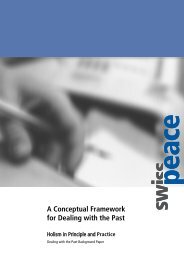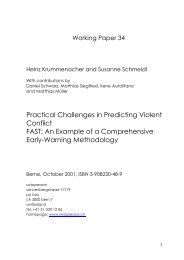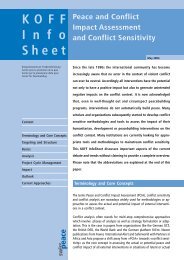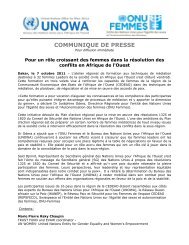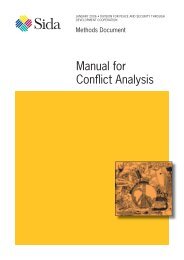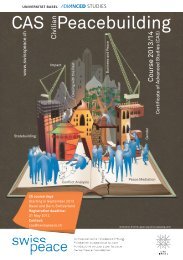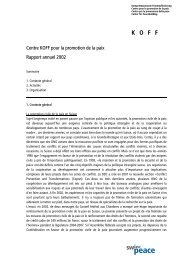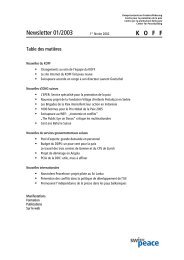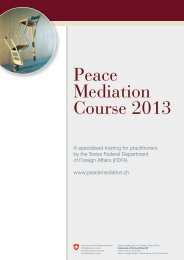Unpacking the Mystery of Mediation in African Peace ... - Swisspeace
Unpacking the Mystery of Mediation in African Peace ... - Swisspeace
Unpacking the Mystery of Mediation in African Peace ... - Swisspeace
Create successful ePaper yourself
Turn your PDF publications into a flip-book with our unique Google optimized e-Paper software.
Sudan, North-South Comprehensive <strong>Peace</strong> Agreement<br />
South negotiations were an example <strong>of</strong> <strong>the</strong> multiple<br />
use <strong>of</strong> facilitative, formulative, and manipulative<br />
mediation, where approaches <strong>in</strong>volv<strong>in</strong>g both<br />
pressure and dialog were comb<strong>in</strong>ed. Dur<strong>in</strong>g <strong>the</strong><br />
negotiations, pressure and assertiveness were used.<br />
However, this pressure did not come alone, but<br />
toge<strong>the</strong>r with a relationship <strong>of</strong> trust that had been<br />
built up <strong>in</strong> <strong>the</strong> pre-negotiation phase, thus mak<strong>in</strong>g<br />
it far more acceptable. Without some degree<br />
<strong>of</strong> pressure, it is very unlikely that <strong>the</strong> parties<br />
would ever have come to <strong>the</strong> negotiation table.<br />
While concrete solutions were proposed, <strong>the</strong>se<br />
only followed careful study and communication<br />
with all <strong>the</strong> conflict parties – a process that took<br />
many years. The role <strong>of</strong> <strong>the</strong> third parties consisted<br />
not <strong>in</strong> <strong>of</strong>fer<strong>in</strong>g solutions, but ra<strong>the</strong>r <strong>in</strong> be<strong>in</strong>g receptive,<br />
listen<strong>in</strong>g, understand<strong>in</strong>g, and <strong>the</strong>n reflect<strong>in</strong>g<br />
perceptions <strong>of</strong> common ground – complemented<br />
by a degree <strong>of</strong> openness on <strong>the</strong> part <strong>of</strong><br />
<strong>the</strong> conflict parties to agree to modifications. The<br />
mediation efforts were team efforts, <strong>in</strong>volv<strong>in</strong>g<br />
both <strong>African</strong>s and Westerns. The team nature <strong>of</strong><br />
mediation is noteworthy: at least ten people were<br />
<strong>in</strong>volved <strong>in</strong> <strong>the</strong> Nuba ceasefire negotiations, and<br />
11 <strong>in</strong> <strong>the</strong> CPA negotiations. In addition, a variety<br />
<strong>of</strong> roles were <strong>in</strong>volved, such as that <strong>of</strong> <strong>the</strong> lowpr<strong>of</strong>ile<br />
facilitator <strong>in</strong> <strong>the</strong> pre-negotiation phase, <strong>the</strong><br />
chief mediator act<strong>in</strong>g as moral guarantor <strong>in</strong> <strong>the</strong><br />
negotiation phase, and <strong>the</strong> mediator deal<strong>in</strong>g with<br />
<strong>the</strong> nuts and bolts dur<strong>in</strong>g <strong>the</strong> negotiations.<br />
Negotiations are only possible with a certa<strong>in</strong> degree<br />
<strong>of</strong> power symmetry between <strong>the</strong> parties.<br />
Knowledge is one form <strong>of</strong> power; thus, when <strong>the</strong><br />
mediators perceived an asymmetry <strong>in</strong> knowledge<br />
about certa<strong>in</strong> issues to be negotiated, <strong>the</strong>y slowed<br />
<strong>the</strong> process down and <strong>in</strong>troduced external experts<br />
to coach both parties. This helped to br<strong>in</strong>g <strong>the</strong><br />
parties up to <strong>the</strong> same level <strong>of</strong> expertise, to <strong>the</strong>n<br />
resume negotiat<strong>in</strong>g on a level lay<strong>in</strong>g field. External<br />
experts were used a lot: for oil, bank<strong>in</strong>g, land<br />
issues, military questions such as DDR, etc.<br />
Participation and Inclusiveness<br />
The ma<strong>in</strong> conflict parties, <strong>the</strong> GoS and <strong>the</strong><br />
SPLM/A, were <strong>in</strong>cluded <strong>in</strong> <strong>the</strong> negotiations.<br />
SPLM was part <strong>of</strong> <strong>the</strong> National Democratic Alliance<br />
(NDA), <strong>the</strong>reby <strong>in</strong> part represent<strong>in</strong>g or at<br />
least <strong>in</strong>form<strong>in</strong>g <strong>the</strong> Nor<strong>the</strong>rn opposition parties.<br />
By deal<strong>in</strong>g with a variety <strong>of</strong> topics (such as land<br />
tenure), <strong>the</strong> <strong>in</strong>clusiveness <strong>of</strong> <strong>the</strong> process was<br />
partly, as stakeholders had to be brought <strong>in</strong> to<br />
discuss <strong>the</strong> issue. In this way, traditional leaders<br />
and women could – at least <strong>in</strong> part – be consulted.<br />
In short, <strong>the</strong> process was very <strong>in</strong>clusive <strong>in</strong><br />
terms <strong>of</strong> topics, but less <strong>in</strong>clusive <strong>in</strong> terms <strong>of</strong> actors.<br />
Efforts by <strong>the</strong> parties to make <strong>the</strong> process<br />
more <strong>in</strong>clusive <strong>in</strong> terms <strong>of</strong> actors were rejected by<br />
<strong>the</strong> conflict parties.<br />
Key Aspects <strong>of</strong> <strong>the</strong> CPA 207<br />
The key issues dealt with <strong>in</strong> <strong>the</strong> peace process and<br />
agreed <strong>in</strong> <strong>the</strong> 260-page Comprehensive <strong>Peace</strong><br />
Agreement (CPA), signed <strong>in</strong> 9 January 2005, <strong>in</strong>cluded<br />
<strong>the</strong> relationship between religion and<br />
state, wealth- (oil) and power-shar<strong>in</strong>g (<strong>in</strong>terim<br />
government, asymmetrical federal system), <strong>the</strong><br />
three contested areas (Blue Nile Hills, Abyei, and<br />
Nuba mounta<strong>in</strong>s), human rights, and security<br />
(armed forces, SSR, DDR) issues. In particular,<br />
<strong>the</strong> parties agreed on <strong>the</strong> follow<strong>in</strong>g:<br />
1. Autonomy: <strong>the</strong> South to be given autonomous<br />
status for six years and a referendum to be<br />
held <strong>in</strong> 2011 regard<strong>in</strong>g secession from Sudan.<br />
2. Security and armed forces: separate armed<br />
forces, as well as <strong>in</strong>tegrated units <strong>of</strong> 21,000<br />
soldiers (half GoS, half SPLA troops). If after<br />
<strong>the</strong> <strong>in</strong>terim period <strong>of</strong> six years <strong>the</strong> South<br />
should decide not to secede, both sides to<br />
unify <strong>in</strong>to a 39,000 strong force.<br />
3. Wealth-shar<strong>in</strong>g: Oil to be shared <strong>in</strong> equal<br />
parts between <strong>the</strong> GoS and <strong>the</strong> SPLM/A.<br />
Two per cent <strong>of</strong> <strong>the</strong> revenues go to <strong>the</strong> region<br />
produc<strong>in</strong>g <strong>the</strong> oil.<br />
4. Economic issues: two currencies <strong>in</strong> a dual<br />
bank<strong>in</strong>g system.<br />
5. Adm<strong>in</strong>istration: positions <strong>in</strong> <strong>the</strong> central transitional<br />
government are split 50-50. In <strong>the</strong><br />
three disputed areas (Abyei, Nuba Mounta<strong>in</strong>s,<br />
and Blue Nile), <strong>the</strong> ratio to be 55-45 <strong>in</strong><br />
favor <strong>of</strong> <strong>the</strong> GoS. Al-Bashir to be head <strong>of</strong><br />
207 Summarized from: Hott<strong>in</strong>ger, Julian: “Mediat<strong>in</strong>g <strong>the</strong> Burundi<br />
and Sudan North-South <strong>Peace</strong> Agreement”, work<strong>in</strong>g paper <strong>of</strong><br />
<strong>the</strong> “<strong>Peace</strong> <strong>Mediation</strong> Course”, Swiss Federal Department <strong>of</strong><br />
Foreign Affairs and <strong>Mediation</strong> Support Project (Center for Security<br />
Studies, Swiss Federal Institute <strong>of</strong> Technology<br />
(ETH)/swisspeace), unpublished (2008).<br />
75




